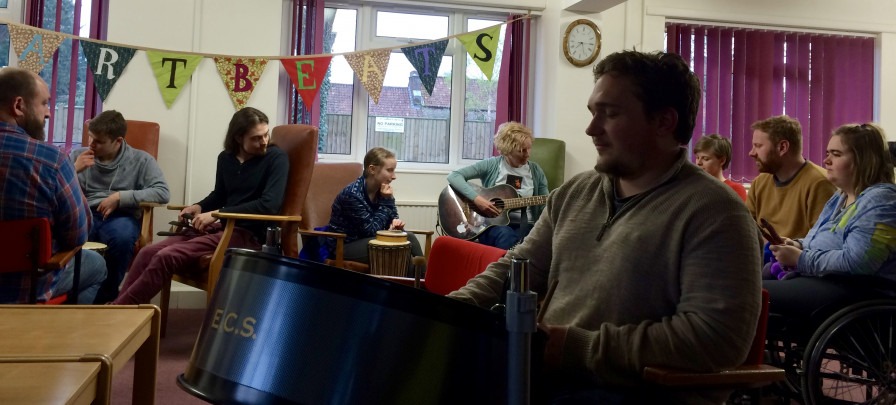Integration and inclusion – is there a difference?

If you are reading this then you know and understand Youth Music’s vision - that life-changing music-making should be available to all children and young people. AllStars music, our Fund B initiative, explores integration as a step forward for the musical inclusion agenda.
Inclusion, access and diversity
As grant holders, we provide activities that achieve personal, social and musical outcomes for children and young people in challenging circumstances.
It’s exciting, challenging and ground breaking stuff . Inclusion, access and diversity are words that we all use now when thinking about music.
Workforce development
Here at Count Me In we’ve been exploring the power of music for young people with additional needs since we founded our organisation in 2002. Our projects use music to benefit young people with SEN/D who are in transition – moving from school to college, to work, to adult services, leaving home and living independently.
Alongside this, we’ve been offering placements to other young musicians wanting experience of community approaches and inclusive practice. These young people are in transition too, and are considering using community music practice, and music therapy, in their future careers.
We’re exploring what we define as ‘music education by encounter’. Who learns what from whom? How does this learning happen? How do we facilitate this?
User-led learning environments
Inclusive practice works with young musicians – we don’t deliver projects ‘for’ them, or ‘to’ them. User-led is the password.
Youth Music funding invites us to create change. It can be challenging balancing user-led work with a progressive programme that extends horizons. Many SEN/D young musicians have barriers to self advocacy and may not progress in ‘conventional’ ways. Formal models of music education aiming towards excellence may not be relevant.
Our work emphasises process over product. We want young musicians with SEN/D to experience the unexpected and play with new ideas, whilst feeling supported and comfortable enough to break routines.
Experts by experience
Of course we plan for progress, but in any group with additional needs things often shoot off down unexplored byways. Sometimes as music leaders we have to take a deep breath and just trust.
But we must never forget that in terms of a life lived, these young people are the experts by experience. The starting point for a creative exchange is to listen well, understand your group, and work creatively.
Inclusion and integration.
Inclusive practice offers something broad and accessible enough to meet the learning needs of everyone participating. It’s an agenda that is inspiring so much inspiring new ideas and technologies across the UK.
‘The ultimate goal for inclusive music …is to develop learning environments where students both with and without disabilities participate successfully and happily in meaningful music experiences.’ (Judith Jellison, Oxford Handbook of Music Education 20102)
And integration? We’ve been exploring this.
It’s straightforward to see that ‘segregation’ is not useful in participatory arts. So – integration is an interesting way forward, extending the basic inclusion agenda.
One dictionary definition of integration is ‘to combine two or more things in order to become more effective.’
For us, integration adds another dimension to the outcomes of our music inclusion work.
In our workshops assimilated, mixed groups of young musicians come together to play music. Our ‘ensemble’ group all aim to use music in their careers. They participate on an equal basis with SEN/D young musicians. Our music leaders create an inclusive environment where everyone is invited to play on their own terms.
Both cohorts remain discrete in that they have fundamentally different reasons for being in the room – educational backgrounds, additional needs and abilities, anticipated outcomes and aspirations.
We use open improvisation techniques that include and integrate. There’s plenty of risk taking, and as you can imagine – much innovation and fun.
Alongside this, we offer development days for the trainee musicians to reflect and learn about the ethos that underpins what we do.
Reflection.
Is this approach working? We're exploring that, and defining outcomes.
We share our aims with our SEN/D group, inviting response. ‘We think playing music together is a good way for people to meet, learn and make friends. We can do this better by…’’ -'experimenting with different types of music'
’inviting guest musicians.’ ‘
It’s exquisite!’
We asked our ‘ensemble’(trainees) for their thoughts after a development session.
‘- JOYOUS! – Expressive, relaxed, informative, and personal in the sense that I felt as if I and other members of the group were expressing personal things through spontaneous music making.’
‘- a different outlook on improvising and listening to one another.’
‘Thank you so much, for the amazing work, time, care, love and joy you all share with us. I will treasure today, and all past HeartBeats sessions at Wells, and all future ones – through my whole life ‘
